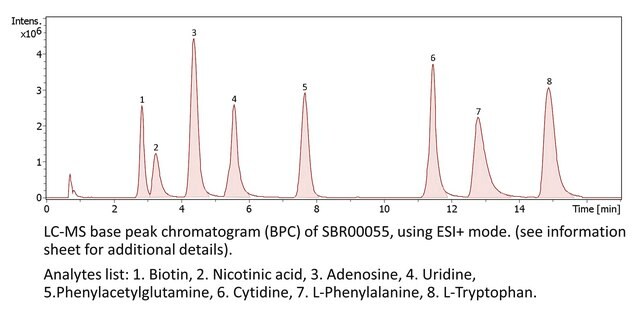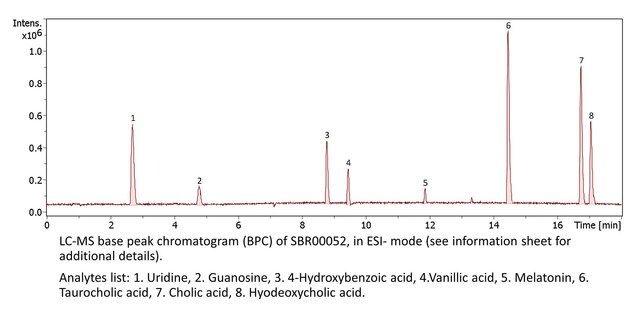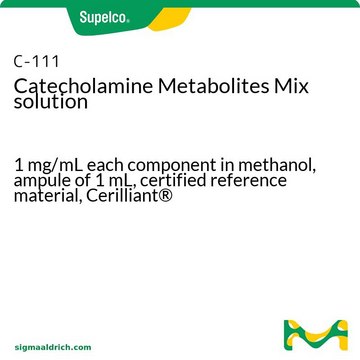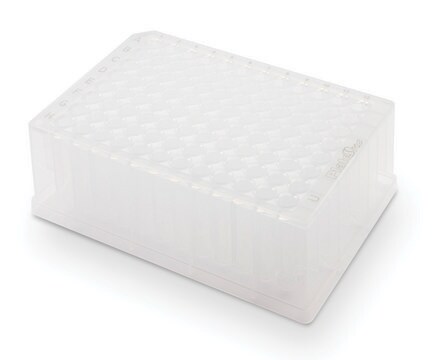SBR00073
Non Polar Metabolites QC Mix
suitable for LC/MS
About This Item
Polecane produkty
Formularz
liquid
Poziom jakości
metody
LC/MS: suitable
Zastosowanie
lipidomics
metabolomics
temp. przechowywania
−20°C
Opis ogólny
Non Polar Metabolites QC Mix to gotowy do użycia roztwór (~2:1:1 IPA:ACN:H20) do spektroskopii masowej. Korzystając z mieszanki QC, użytkownik będzie mógł ocenić zjawiska dryfowania i tłumienia jonów. Non Polar Metabolites QC Mix składa się z dziewięciu składników, które zawierają hydrofobowe metabolity, takie jak pochodne cholesterolu, nienasycone kwasy tłuszczowe, fosfolipidy i ceramidy.
Cechy i korzyści
- Mieszanina QC niepolarnych metabolitów obejmuje zakres mas ~ 100-800 Da
- Mieszanina została zaprojektowana do detekcji ESI (+/-)
- Mieszanina jest dostarczana w postaci gotowego do użycia roztworu (~2:1:1 IPA:ACN:H20) w bursztynowej fiolce z zaciskanym wieczkiem (wkładka silikonowa/PTFE), która nadaje się do użytku z większością autosamplerów LC-MS.
- Zalecana temperatura przechowywania mieszaniny wynosi -20°C, rozmrażanie próbki nie jest wymagane. Ogrzać próbkę do temperatury pokojowej i krótko wymieszać.
Komponenty
D-Sphingosine
1-Oleoyl-sn-glycero-3-phosphocholine (LysoPC(18:1(9Z)/0:0))
Linolenic acid
Arachidonic acid sodium salt
cis-4,7,10,13,16,19-Docosahexaenoic acid
Cholesterol sulfate
N-palmitoyl-D-sphingosine (C16 Ceramide (d18:1/16:0))
1,2-Dioleoyl-sn-glycero-3-phosphocholine (18:1 (Δ9-Cis) PC (DOPC))
produkt powiązany
Hasło ostrzegawcze
Warning
Zwroty wskazujące rodzaj zagrożenia
Zwroty wskazujące środki ostrożności
Klasyfikacja zagrożeń
Eye Irrit. 2 - Flam. Liq. 3 - STOT SE 3
Organy docelowe
Central nervous system
Kod klasy składowania
3 - Flammable liquids
Klasa zagrożenia wodnego (WGK)
WGK 2
Temperatura zapłonu (°F)
89.6 °F
Temperatura zapłonu (°C)
32 °C
Wykazy regulacyjne
Wykazy regulacyjne dotyczą głównie produktów chemicznych. Można w nich podawać ograniczoną liczbę informacji na temat produktów niechemicznych. Brak wpisu oznacza, że żaden ze składników nie znajduje się w wykazie. Użytkownik odpowiada za zagwarantowanie bezpiecznego i zgodnego z prawem stosowania produktu.
EU REACH Annex XVII (Restriction List)
Wybierz jedną z najnowszych wersji:
Certyfikaty analizy (CoA)
It looks like we've run into a problem, but you can still download Certificates of Analysis from our Dokumenty section.
Proszę o kontakt, jeśli potrzebna jest pomoc Obsługa Klienta
Masz już ten produkt?
Dokumenty związane z niedawno zakupionymi produktami zostały zamieszczone w Bibliotece dokumentów.
Nasz zespół naukowców ma doświadczenie we wszystkich obszarach badań, w tym w naukach przyrodniczych, materiałoznawstwie, syntezie chemicznej, chromatografii, analityce i wielu innych dziedzinach.
Skontaktuj się z zespołem ds. pomocy technicznej










